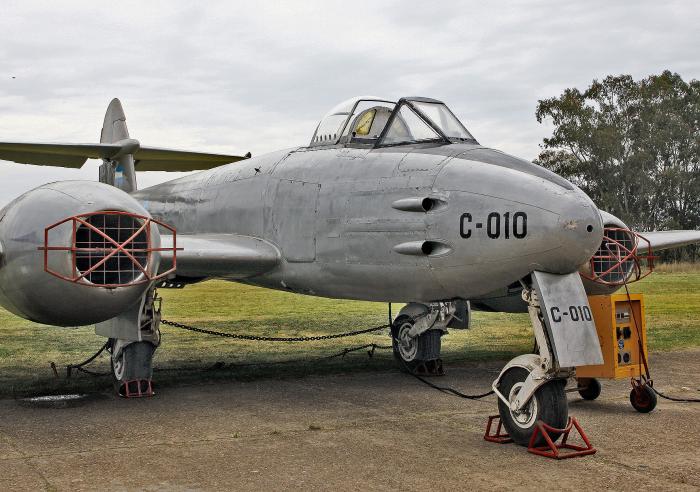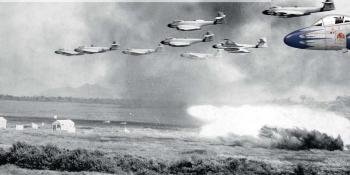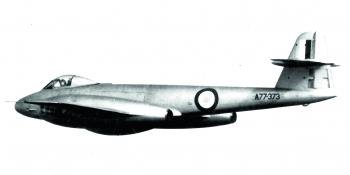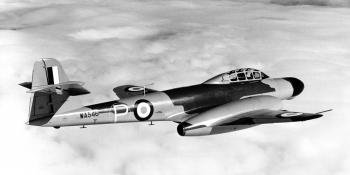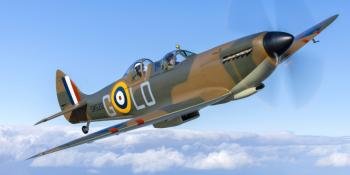Various year groups at a college in Argentina have progressed a Meteor restoration project
The Gloster Meteor C-010, originally RAF RA393/EE393, was built in 1945 as the Mk. III and purchased by the Argentinean government from the RAF in 1948 as the Mk. IV, along with another 100 planes. On March 3rd, 1948, it was added to the Argentinean Air Force as I-010 (Interceptor) and assigned to the 4th Fighter Regiment. Later, it was transferred to the 2nd Fighter Group.
After several flights and repairs, it was reassigned to a fighter-bomber role and renamed C-010 (with the first letter of the word "Caza-Bombardero") in 1959. It continued its service until May 1970 when it was decommissioned with 1,353 flight hours. It was then delivered as didactic material to Technical School number 4 (now Technical School number 7) within the Air Force base called "Quilmes Material Area". Quilmes is a city on the coast of the Río de la Plata, southeast of Greater Buenos Aires.
Since then, many groups of students in their final year have worked on the plane, repairing different parts as part of their graduation projects in Aeronautic Mechanics. However, over the last decades, the missing parts and years of disuse have made the repair and restart of the two Derwent V jet engines increasingly difficult. In 2019, a group of students in their 6th year of school, with one year remaining before starting their graduation project, initiated conversations with the Jet engines Professor and the Headmaster to seek approval to begin working on the Gloster Meteor one year ahead of schedule.
The students were aware of the potential challenges the project might entail and wanted to ensure they had enough time to make the engines work. The Headmaster, who had worked on the plane as a student himself and had heard the engines roar in the past, approved their request to start one year earlier. This allowed the group to begin their work in 2019. The original idea was to repair both engines and paint the plane with its disruptive coloration camouflage instead of the dull aluminum color. They started from scratch, obtaining the plane manuals and lifting it from its resting position nose down in the school hangar, where it lay with a flat tire. The first challenge was to identify the position to hook the jack provided by the air force to lift the plane.
They had to build specific pieces to ensure a perfect fit and avoid any damage to the plane's wings. After overcoming that obstacle and repairing the flat tire, they constructed a cradle to support the engines once they were removed from the Meteor wings. Another cradle was needed to rest the air intakes and allow access to the engines. When everything was ready, the big day arrived. The first Derwent V engine was lifted and placed on the cradle for the students to work on. They disassembled, cleaned, and individually tested all the ignition systems. They also had to change a corroded fuel tank and ensure the fuel system's tightness for safe operation. The plane's cabin had no instruments, and all the electrical connections were gone. They had to study them from the manual and first rebuild an external electrical panel to operate the engine from the ground. They also created a test bench to work on the engines.
By the end of October, they had managed to make the first engine work. However, due to the lack of plane instruments, it was deemed dangerous to turn it on at more than 3,500 RPM. Therefore, they settled for showing the engine at the year-end School Fair, connected to an external electrical starter, running at a very slow speed. Everyone encouraged them for the significant progress made, considering they still had a full year in 2020 to make both engines work with the planned instruments. During the summer, the group toured many museums, buildings, and squares where Meteors were exhibited, attempting to obtain the missing instruments. However, they had little success. One of the students, whose father had also worked on the plane as a student, purchased the minimum instruments needed to safely start the engines from a collector in the UK. The group was also allowed to work on the landing gear during the summer break, and everything was ready to begin the final phase in March 2020. However, the COVID-19 pandemic disrupted their plans, and the group realized they would not be able to finish their project.
By the end of 2020, before their graduation, they had designed and planned the remaining steps of the restoration and identified a successor for their project: a group that would enter their 6th year in 2021. One of the students had a brother in that group, ensuring they would have enough time and enabling successful knowledge transfer. Unfortunately, 2021 was still not a full-time year at school, and the project could only be restarted when the new group reached their 7th and final year. The 2019 team visited the school during the first weeks of classes and passed the baton to their successors. With the instruments in place, the new team had to check theories to understand the hurdles they faced in making the engine work at a slow speed on the ground. The 2019 group had discovered some oil leaks that needed fixing, but the necessary joints were unavailable. Therefore, the new team had to make them from scratch based on the manual's drawings. They also repaired the school's electrical starter to provide the correct power. Additionally, they replaced the fuel pump joints and the micropump joints, as the pump was not delivering sufficient air pressure and the fuel droplets were too large to sustain combustion.
With all the repairs completed, on August 5th, 2022, the right engine roared to life after 22 years. The Instagram profile that the 2019 group had started, which showcased the progress step by step, gained significant attention when a short video of the first engine running was shared. A few days later, a second attempt was made, with many members of the 2019 group present to witness their dream come true. The work continued to install the engine in the plane, connect all the electrical panels inside the cabin, and extract and repair the second engine. The Instagram account now has over 12,000 followers from around the world and has facilitated connections with Meteor Mechanics who have reached out to the school to offer valuable knowledge and support, considering the plane's age. The 2022 team showcased the plane with both engines running at the year-end fair on November 11th and 12th, 2022.
A large group of visitors of all ages cheered and celebrated the accomplishment. They have also chosen a successor who will continue the original project in the coming years. There is still much to be done, including painting, working on the landing gear, and the brake system. These students chose this plane among others available at the school due to the challenge of bringing the first Allied jet fighter back to life after many years. The project has not only provided them with an opportunity to learn and graduate but has also brought together a community of students from several school cohorts who have worked on the plane over the decades. The plane mechanics, who still possess valuable knowledge, and the numerous fans around the world have enthusiastically followed and cheered for every step of this magical journey.
At the beginning of 2023, a new group of students chose to continue enhancing the Gloster Meteor as their project for their final year before graduating. So far this year, they have worked on the hydraulic system of the landing gear. Initially, the aircraft was lifted, fixed, and the landing gear underwent inspections. The systems' operation was tested using a manual hydraulic pump. The moving parts, such as the actuators, hydraulic system pistons, flaps, and aerodynamic brake, were disassembled and cleaned. Poorly conditioned alemites were replaced, and the moving parts were lubricated and greased. Subsequently, the complete operation of the system was tested using a hydraulic mule. Additionally, some wing structure ribs in poor condition were fabricated and replaced.
In recent months, they have also been working on the removal of corrosion and rust using products donated by the American company WD-40. They are currently preparing and sanding for a new paint application. They plan to paint the aircraft with the colors of the original tactical camouflage scheme from its early years, which features green and gray when viewed from above, and light blue when viewed from below. The entire paint supplies are generously donated by the American company Sherwin Williams as part of their Corporate Social Responsibility program.
